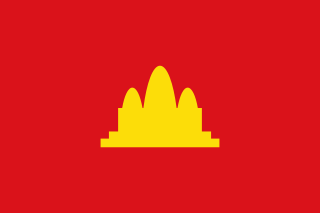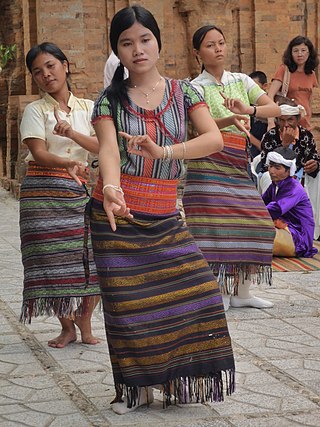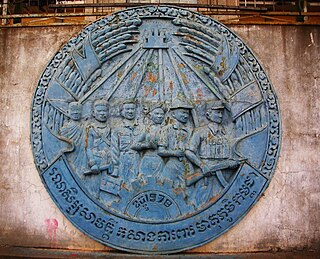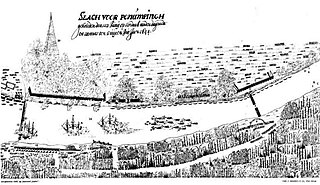
The Khmer Rouge is the name that was popularly given to members of the Communist Party of Kampuchea (CPK) and by extension to the regime through which the CPK ruled Cambodia between 1975 and 1979. The name was coined in the 1960s by then Chief of State Norodom Sihanouk to describe his country's heterogeneous, communist-led dissidents, with whom he allied after his 1970 overthrow.

Pol Pot was a Cambodian communist revolutionary, politician and a dictator who ruled Cambodia as Prime Minister of Democratic Kampuchea between 1976 and 1979. Ideologically a communist and a Khmer ethnonationalist, he was a leading member of Cambodia's communist movement, the Khmer Rouge, from 1963 to 1997 and served as General Secretary of the Communist Party of Kampuchea from 1963 to 1981. His administration converted Cambodia into a one-party communist state and perpetrated the Cambodian genocide.

The Chams, or Champa people, are an Austronesian ethnic group in Southeast Asia as well as an indigenous people of central Vietnam. They are the original inhabitants of coastal areas in Vietnam and Cambodia, along the South China Sea, since before the arrival of the Cambodians and Vietnamese, during the expansion of the Khmer Empire and the Vietnamese conquest of Champa.

The post-Angkor period of Cambodia, also called the Middle Period, refers to the historical era from the early 15th century to 1863, the beginning of the French protectorate of Cambodia. As reliable sources are very rare, a defensible and conclusive explanation that relates to concrete events that manifest the decline of the Khmer Empire, recognised unanimously by the scientific community, has so far not been produced. However, most modern historians have approached a consensus in which several distinct and gradual changes of religious, dynastic, administrative and military nature, environmental problems and ecological imbalance coincided with shifts of power in Indochina and must all be taken into account to make an interpretation. In recent years scholars' focus has shifted increasingly towards human–environment interactions and the ecological consequences, including natural disasters, such as flooding and droughts.

Son Sen, alias Comrade Khieu (សមមិត្តខៀវ) or "Brother Number 89", was a Cambodian Communist politician and soldier. A member of the Central Committee of the Communist Party of Kampuchea/Party of Democratic Kampuchea, the Khmer Rouge, from 1974 to 1992, Sen oversaw the Party's security apparatus, including the Santebal secret police and the notorious security prison S-21 at Tuol Sleng.

Ieng Sary was the co-founder and senior member of the Khmer Rouge and one of the main architects of the Cambodian Genocide. He was a member of the Central Committee of the Communist Party of Kampuchea led by Pol Pot and served in the 1975–79 government of Democratic Kampuchea as foreign minister and deputy prime minister. He was known as "Brother Number Three", as he was third in command after Pol Pot and Nuon Chea. His wife, Ieng Thirith, served in the Khmer Rouge government as social affairs minister. Ieng Sary was arrested in 2007 and was charged with crimes against humanity but died of heart failure before the case against him could be brought to a verdict.
Benedict F. "Ben" Kiernan is an Australian-born American academic and historian who is the Whitney Griswold Professor Emeritus of History, Professor of International and Area Studies and Director of the Genocide Studies Program at Yale University.

Islam in Vietnam is primarily the religion of the Cham people, an Austronesian minority ethnic group; however, roughly one-third of Muslims in Vietnam are of other ethnic groups. There is also a community, which describes itself as of mixed ethnic origins, that practices Islam and is also known as the Cham, or Cham Muslims, around the region of Châu Đốc in the Southwest.

The largest of the ethnic groups in Cambodia are the Khmer, who comprise 95.8% of the total population and primarily inhabit the lowland Mekong subregion and the central plains. The Khmer historically have lived near the lower Mekong River in a contiguous arc that runs from the southern Khorat Plateau where modern-day Thailand, Laos and Cambodia meet in the northeast, stretching southwest through the lands surrounding Tonle Sap lake to the Cardamom Mountains, then continues back southeast to the mouth of the Mekong River in southeastern Vietnam.

Kampuchea, officially Democratic Kampuchea (DK) from 1976 onward, was the Cambodian state from 1975 to 1979, under the totalitarian dictatorship of Pol Pot and the Communist Party of Kampuchea (CPK), commonly known as the Khmer Rouge (KR). It was established following the Khmer Rouge's capture of the capital Phnom Penh, effectively ending the United States-backed Khmer Republic of Lon Nol. After Vietnam took Phnom Penh in 1979, it was disestablished in 1982 with the creation of the CGDK in its place.

The People's Republic of Kampuchea (PRK) was a partially recognised state in Southeast Asia which existed from 1979 to 1989. It was a client state of Vietnam, founded in Cambodia by the Vietnamese-backed Kampuchean United Front for National Salvation, a group of Cambodian communists who were dissatisfied with the Khmer Rouge due to its oppressive rule and defected from it after the overthrow of Democratic Kampuchea, Pol Pot's government. Brought about by an invasion from Vietnam, which routed the Khmer Rouge armies, it had Vietnam and the Soviet Union as its main allies.
Buddhism is the state religion of Cambodia. Approximately 97% of Cambodia's population follows Theravada Buddhism, with Islam, Christianity, and tribal animism as well as Baha’i faith making up the bulk of the small remainder. The wat and sangha (monkhood), together with essential Buddhist doctrines such as reincarnation and the accumulation of merit, are at the centre of religious life.

The Kampuchean United Front for National Salvation often simply referred to as Salvation Front, was the nucleus of a new Cambodian regime that would topple the Khmer Rouge and later establish the People's Republic of Kampuchea (PRK).

The United Front for the Liberation of Oppressed Races was an organization whose objective was autonomy for various indigenous peoples and ethnic minorities in South Vietnam, including the Montagnards in the Central Highlands, the Chams in Central Vietnam, and the Khmer Krom in Southern Vietnam. Initially a political movement, after 1969 it evolved into a fragmented guerrilla group that carried on simultaneous insurgencies against the governments of South Vietnam under President Nguyen Van Thieu and North Vietnam of Ho Chi Minh. Opposed to all forms of Vietnamese rule, FULRO fought against both sides in the Vietnam War against the Soviet-aligned North and the American-aligned South at the same time. FULRO's primary supporter during the 1960s and early 1970s conflict in Southeast Asia was Cambodia, with some aid sent by the People's Republic of China during the period of the Third Indochina War.

Cambodia–Vietnam relations take place in the form of bilateral relations between the Kingdom of Cambodia and the Socialist Republic of Vietnam. The countries have shared a land border for the last 1,000 years and share more recent historical links through being part of the French colonial empire. Both countries are members of the Association of Southeast Asian Nations (ASEAN).

The Communist Party of Kampuchea (CPK), also known as the Khmer Communist Party, was a communist party in Cambodia. Its leader was Pol Pot, and its members were generally known as the Khmer Rouge. Originally founded in 1951, the party was split into pro-Chinese and pro-Soviet factions as a result of the Sino–Soviet split with the former being the Pol Pot faction, and the latter adopting a more revisionist approach to Marxism. As such, it claimed that 30 September 1960 was its founding date; it was named the Workers' Party of Kampuchea before it was renamed the Communist Party in 1966.

Cambodian genocide denial is the belief expressed by some Western academics that early claims of atrocities committed by the Khmer Rouge government (1975–1979) in Cambodia were much exaggerated. Many scholars of Cambodia and intellectuals opposed to the US involvement in the Vietnam War denied or minimized reports of human rights abuses of the Khmer Rouge, characterizing contrary reports as "tales told by refugees" and US propaganda. They viewed the assumption of power by the Communist Party of Kampuchea as a positive development for the people of Cambodia who had been severely impacted by the Vietnam War and the Cambodian Civil War. On the other side of the argument, anti-communists in the United States and elsewhere saw in the rule of the Khmer Rouge vindication of their belief that the victory of Communist governments in Southeast Asia would lead to a "bloodbath."

The Cambodian genocide was the systematic persecution and killing of Cambodian citizens by the Khmer Rouge under the leadership of Prime Minister of Democratic Kampuchea, Pol Pot. It resulted in the deaths of 1.5 to 2 million people from 1975 to 1979, nearly 25% of Cambodia's population in 1975.

The Cambodian–Dutch War from 1643–1644 was a conflict sparked by a coup which brought a new Cambodian King to the throne who converted to Islam with the help of Malay traders resident in the country. The new King initiated a massacre of Dutch East India Company employees and subsequently defeated the Dutch forces sent to extract retribution from the Cambodians.
So Phim was a Khmer Issarak, No. 3 of the Permanent Bureau and of the Military Bureau of the Central Committee of the Communist Party of Kampuchea, deputy head of the People's National Liberation Armed Forces of Kampuchea, secretary of East Zone of the Democratic Kampuchea of the Khmer Rouge, until he refused to apply the Cambodian genocide designed by Pol Pot and his comrades causing his death in June 1978.

















